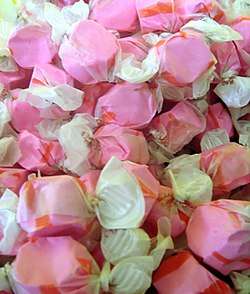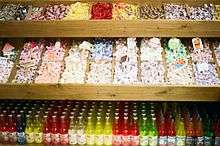Taffy (candy)
Taffy (American English) is a type of candy. Taffy is made by stretching or pulling a sticky mass of boiled sugar, butter or vegetable oil, flavorings, and colorings until it becomes aerated (meaning that tiny air bubbles are produced, resulting in a light, fluffy and chewy candy).[1] When this process is complete, the taffy is rolled, cut into small pastel-colored pieces and wrapped in wax paper to keep it soft. It is usually fruit-flavored, but other flavors are common as well, including molasses and the "classic" (unflavored) taffy.
 | |
| Main ingredients | Sugar, butter or vegetable oil, flavorings, food coloring |
|---|---|
US
A recipe for the candy appeared in the 1887 White House cook book.[2] Its ingredients are corn syrup, sugar, blackstrap molasses, coconut oil, salt, cotton stearine, mono and diglycerides, soy lecithin and artificial flavour.[3]
Salt water taffy
 Salt water taffy with a U.S. quarter for scale | |
| Type | Taffy |
|---|---|
| Place of origin | United States |
| Region or state | Atlantic City, New Jersey |
| Main ingredients | sugar, cornstarch, corn syrup, glycerine, water, butter, salt, flavoring, food coloring |
Salt water taffy is a variety of soft taffy originally produced and marketed in the Atlantic City, New Jersey area of the Jersey Shore starting in the 1880s.[4] Its late 19th century appellation which most likely originated in New Jersey, United States.[5] Salt water taffy is still sold widely on the boardwalks in Atlantic City (including shops in existence since the 19th century),[6] nearby Ocean City, and other popular beaches throughout the United States like Cape Cod. It is also popular in Atlantic Canada, and Salt Lake City, Utah.
Modern commercial taffy is made primarily from corn syrup, glycerin and butter. The pulling process, which makes the candy lighter and chewier, consists of stretching out the mixture, folding it over and stretching it out again. Although it is called "salt water" taffy, it does not include any seawater but does contain both salt and water in its manufacture.[7] In the local Philadelphia dialect, the term "taffy" without "salt water" refers to a lollipop.[8]
The original invention of the candy has several different stories circulating, likely all apocryphal. One relates to an assistant who substituted fresh water with sea water—either through laziness or accident. Another cites a storm which caused ocean water to wash over the candy, which was consequently (and successfully) marketed with the appropriate name.[9] Joseph Fralinger popularized the candy by boxing it and selling it in Atlantic City. Fralinger's first major competition came from candy maker Enoch James, who refined the recipe, making it less sticky and easier to unwrap. James also cut the candy into bite-sized pieces, and is credited with mechanizing the "pulling" process. The candy was also sold mail order; in 1926 sheet music was commissioned by James with the title "Send Home Some Taffy Today!" [10] Both Fralinger's and James's stores still operate on the Atlantic City boardwalk. Both companies have been owned and operated by the Glaser family since 1947.[11][9]
On August 21, 1923, John Edmiston obtained a trademark for the name "salt water taffy" (number 172,016), then demanded royalties from companies using his newly acquired name. He was sued over this demand, and in 1925, the trademark was invalidated as being in common use.
Caramel candies are sometimes referred to as taffy (taffy apples), but are very different from common salt water taffy.
Ingredients


Salt water taffy is composed of sugar, cornstarch, corn syrup, glycerine, water, butter, salt, natural and/or artificial flavor, and food color. Some examples of flavoring include vanilla, lemon, maple, banana, red licorice, watermelon, raspberry or mint extracts.[7] Despite its name, the taffy contains no salt water (seawater), but does contain both salt and water.
UK
In the United Kingdom, taffy pieces are known as "chews" or "fruit chews"[12]—the term "taffy" is practically unknown. Popular brands of chew include Chewits and Starburst (Opal Fruits).[12]
Canada
In Canada, a form of molasses taffy candy, known as "hallowe'en kisses", is produced in time for the Hallowe'en occasion.[2] The candy was first offered by the Kerr's Canadian candy company in the 1940s. At the time, a molasses candy was made by Stewart and Young in Glasgow.[2]
External links
| Look up taffy in Wiktionary, the free dictionary. |
References
- "Science of Candy: Why Do You Pull Taffy? - Exploratorium". Exploratorium: the museum of science, art and human perception. Retrieved 2015-11-23.
- "A Trick or a Treat: The story of Canada’s Cursed Candy Kiss". ottawarewind.com. Retrieved November 1, 2019.
- "Molasses Kisses". kerrs.com. Kerr's. Retrieved November 1, 2019.
- Genovese, Peter. "Chew on this: 125 years later, Jersey Shore still daffy over salt water taffy" in The Newark Star Ledger, August 19, 2013
- "Chew on this: 125 years later, Jersey Shore still daffy over salt water taffy".
- Sharkey, Joe (November 11, 2001), "Traces of the place at high tide", The New York Times, retrieved 2011-06-25
- recipe: Saltwater Taffy. Exploratorium, San Francisco, California, USA
- "Yo! And Other Lexicographical Peculiarities". Philadelphia Citypaper. Archived from the original on 2012-07-11.
- "Joseph F. Fralinger, the History of Salt Water Taffy, and the Gager Family". 13 February 2016.
- "Send Some Taffy - James Salt WaterTaffy Advertisement Sheet Music". eBay.
- "Shop Fralinger's Candy – James Candy Company". www.fralingers.com. Archived from the original on 2016-06-23. Retrieved 2016-07-06.
- "What is taffy? Let's make some sense of this oddly confounding chewy sweet". Mr Dach. 2 March 2018.
In most of the UK and Ireland, it’s never taffy — only chews or fruit chews. I